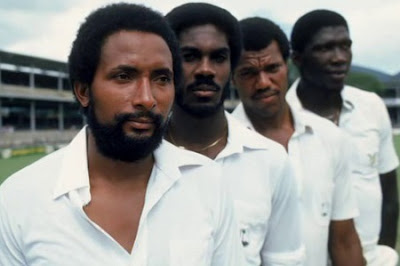Sports Kaleidopedia Feature
Fire in Babylon is a 2010 British documentary film written and directed by Stevan Riley that chronicles the two-decade-long supremacy of the indomitable West Indies cricket teams of the 1970s and 1980s first under the leadership of Clive Lloyd and then under Vivian Richards. Fire in Babylon features stock footage and interviews of several former West Indian players, sports journalists, officials, and musicians including Gordon Greenidge, Desmond Haynes, Deryck Murray, Vivian Richards, Michael Holding, Andy Roberts, Joel Garner and Colin Croft. Fire in Babylon also throws light on Kerry Packer’s World Series Cricket and how it revolutionized the sport. The film begins by giving a brief account of the West Indian cricket during the 50s and 60s, prior to their ascension as a formidable force on the global platform when the highly talented breed of West Indian cricketers were condescendingly dubbed as ‘Calypso Cricketers’, for they were considered quite capable of entertaining in short bursts but not good enough to capitalize on their flashes of brilliance to eke out victories on a regular basis.
In the 1950s, Sir Frank Worrell became the first black man to captain a West Indies cricket team. The era also saw the emergence of great West Indian cricketers such as Everton Weekes and Sir Garfield Sobers. During the period, despite the individual accolades the West Indian cricket could never really emerge as a colossus because of regressive influence of colonialism that continued to the stymie any rising hopes of progression in the West Indian Islands until the late '60s. By the '70s, the West Indian Islands, having finally attained independence, entered a phase of reconstruction. But, the damage had already been done! It was at this point of time that cricket became the greatest hope of the West Indian people. The gradual success of the newly formed team under the leadership of Clove Lloyd seemed to serve as an elixir for the masses. The team’s unprecedented success not only galvanized the natives of the West Indian Islands but also the African community at large. The West Indian players became a beacon of hope for every black individual who was being made to suffer in the name of racism.
However, the team’s rise to unprecedented glory had been far from easy. On the 1975-76 tour of Australia the West Indies Cricket Team had faced utter annihilation at the hands of Dennis Lillee and Jeff Thomson losing the six-match test series 5-1. A bruised and battered West Indian side then went face-to-face against a formidable Indian lineup in 1976. The throbbing at the hands of Australians had made Lloyd and his men learn the hard way that cricket was no longer a “gentlemen’s game” and that winning took more than just good sportsmanship. Prior to the Indian series, Lloyd had enough time to formulate a potent pace attack on the lines of the Australian Cricket Team. Lloyd unleashed his newly devised young battery of fast bowlers comprising Andy Roberts, Michael Holding and Colin Croft against the Indians who found the pace trio too hot to handle and ended up losing the four-match test series 2-1. In fact, half of the Indian Team did not bat in their second innings of the fourth and final test match because of the fear of getting hurt at the hands of the West Indian chin music. Thus began a new chapter in the history of cricket that saw the emergence of West Indies as a force to be reckoned with. It’s a great testament to the might, power and heroics of the great West Indian players of the time that from the February of 1980 to the March of 1995 the West Indies Cricket Team did not lose a single Test series—a remarkable feat that's yet to be matched in any professional team sport.
Fire in Babylon further highlights the discrimination and disparity that the West Indian cricket teams were subjected to following their exaltation as a colossal force in world cricket. While the Press didn’t leave a single stone unturned to malign the West Indian cricketers, the authorities strived to alter the rules and mechanics of the sport in order to curtail the West Indian dominance. Fire of Babylon is a story of self-realization, revival and dominance of a group of men for whom winning became the very purpose of existence and whose struggle and triumph became a symbol of hope for millions of oppressed Africans all across the globe. While Michael Holding, Andy Roberts and Colin Croft earned the sobriquets of “Whispering Death”, "Hitman" and "The Bomber," respectively for their hostile pace bowling, Vivian Richards became the embodiment of courage and bravery for his intrepid style of batting. The tricolor wristband that Richards wore on the cricket field served to be a true manifestation of the African spirit: while green symbolized the evergreen African terrain, gold symbolized the plundered riches of the African land, and red symbolized the African blood shed over the centuries. But, as the West Indian dominance over cricket grew stronger the players who were hitherto termed as outcasts and slaves finally began to be treated as international icons and the cricketers from other nations too started to treat them with equality and respect as hostility made way for camaraderie and bonhomie. The synergy created by the West Indian dominance and Bob Marley’s revolutionary music bolstered the anti-apartheid campaigns taking place all across the world.
Overall, Fire in Babylon is a great means to make acquaintance with the arguably the most formidable lineup of players in any major team sport. Fire in Babylon is an unforgettable tale of human grit, struggle, hardship and triumph that's a must watch for any sports enthusiast. Highly recommended!
(A version of this article was first published in A Potpourri of Vestiges.)
- Murtaza Ali Khan



